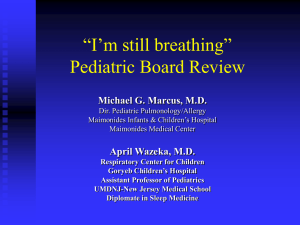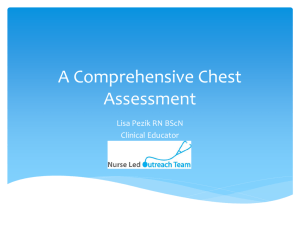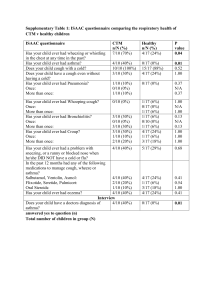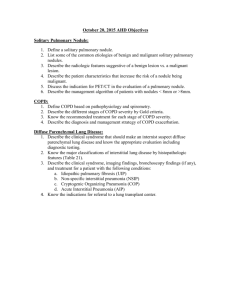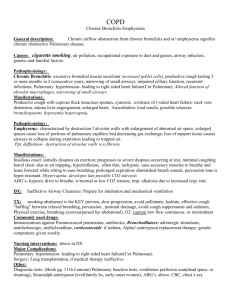Pulmonary Function Testing - American Academy of Pediatrics
advertisement
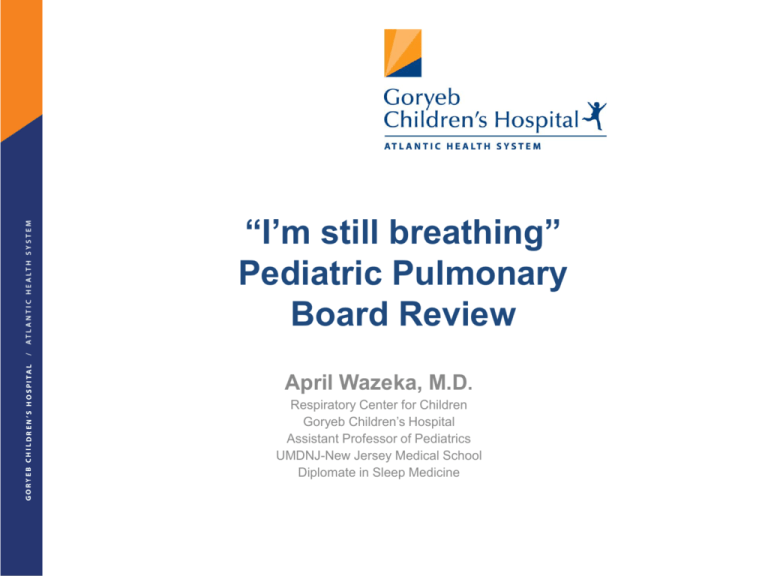
“I’m still breathing” Pediatric Pulmonary Board Review April Wazeka, M.D. Respiratory Center for Children Goryeb Children’s Hospital Assistant Professor of Pediatrics UMDNJ-New Jersey Medical School Diplomate in Sleep Medicine Case Presentation #1 A 5 year old male presents to your office with a chronic cough • Cough is productive, increased at night, recurrent • Worse with exercise and with upper respiratory infections • Growth has been normal • Chest xray findings are normal except for mild hyperinflation Differential Diagnosis: Which is the MOST likely diagnosis? A. Sinusitis B. Asthma C. Gastroesophageal 0% 0% 0% 0% 0% Si nu sit oe is so As ph th ag m ea a lr ef lu x. .. Tu be rc ul os Cy is st ic Ps Fib yc ho ro s is ge ni cc ou gh 0% Ga st r reflux disease D. Tuberculosis E. Cystic Fibrosis F. Psychogenic cough 6 Asthma: Overview Chronic inflammatory disease of the airway Affects 20 million people in the US (9 million children) More than 70% also have allergies Prevalence has increased by almost 40% in all ages in the past decade. Typically develops in childhood-50% before 3 years of age, and the majority before 8 years of age. 470,000 hospitalizations per year Pathogenesis Airway inflammation also contributes to airflow limitation, which includes: • Bronchoconstriction • Edema • Chronic mucus plugging • Airway wall remodeling All this leads to bronchial obstruction All of the following are asthma Risk Factors EXCEPT: Inner city minority Low birth weight Cigarette smoking Family history of asthma E. History of atopy (allergies, eczema) F. Living on a farm A. B. C. D. m L iv in go n af ar s.. . ie 0% fa to py (a lle rg as th m 0% or yo Hi st Fa m ily hi st or y of sm ok i gh t ei et te ar Ci g 0% a 0% ng 0% w h bi rt Lo w In ne r cit y m in or ity 0% 6 History Asthma is primarily a clinical diagnosis • History o Cough o Wheezing o Shortness of breath, particularly with exercise o Chest pain or tightness o “Difficulty catching my breath” o Vomiting, particularly mucus Physical Exam Wheezing Crackles in the lung Muscle retractions Often can be normal Pulmonary Function Testing Determines Degree of airway obstruction Other lung disorders Pulmonary Function Testing Normal Flow Volume Loops Diagnostic Studies Chest xray Immunoglobulins • Identify allergic components • Rule out associated immunodeficiencies Skin testing/RAST testing for allergies Sweat test to rule out Cystic Fibrosis Treatment Bronchodilators • Short-acting Leukotriene modifiers Inhaled corticosteroids Combination therapy (inhaled steroid + long-acting bronchodilator) Systemic steroids (acute exacerbation) Methylxanthines (Theophylline) IgE blocker (Omalizumab (Xolair)) Treatment—Inhaled Steroids Inhaled corticosteroids are standard of care for all categories except for mild intermittent asthma • Long term prevention of symptoms; suppression, control and reversal of inflammation. • Block late reaction to allergen • Reduce airway hyperresponsiveness • Inhibit inflammatory cell migration and activation • Increase B2 receptor affinity Inhaled Steroids Budesonide (Pulmicort®) Fluticasone (Flovent®) Mometasone (Asmanex®) Beclomethsasone (Qvar®) Ciclesonide (Alvesco®) Combination Therapy Fluticasone + Salmeterol (Advair®) Budesonide +Formoterol (Symbicort®) Mometasone +Formoterol (Dulera®) All of the following are side effects of inhaled steroids EXCEPT: A. B. C. D. E. 0% 0% 0% 0% t io ns al th na ru ls sh u . Gr pp ow re ss th io su n pp re ss io Os n te op or os is 0% Ad re Or ita vo ice 0% Pa lp rs e Co u gh 0% Ho a Cough Hoarse voice Palpitations Oral thrush. Adrenal suppression F. Growth suppression G. Osteoporosis 6 Asthma and Exercise Exercise can trigger asthma Symptoms are worse with cold, dry air However, exercise helps lungs function better and prevents obesity As long as asthma is well-controlled and a short-acting bronchodilator (rescue medicine) is used beforehand, children with asthma should be able to do sports Pulmonary function testing best first test; then exercise testing. Case # 2 A 4-month-old infant boy is brought to the Emergency Room because of lethargy. Physical Examination Afebrile HR 160 bpm RR 50 breaths/min SaO2: 98% on RA Weight: 3.2 kg GENERAL : Very thin, appearing to be malnourished; Lethargic but arousable HEENT : dry mucous membranes CHEST : equal breath sounds ABDOMEN : distended; no organomegaly SKIN : decreased turgor and elasticity NEUROLOGIC : poor muscle tone; poor suck Case # 2 (Continued) PMHx: Born at term; No problems at birth. Hospitalized at 1 month of age for pneumonia; Chronic cough; Frequent diarrhea Immunizations: UTD Social Hx: Lives with parents FHx: Cousin with recurrent respiratory infections. Nutrition & Growth: breast fed; used to have good appetite but it got progressively worse; poor weight gain in the beginning; actual weight loss lately After IVF, these are the labs: SERUM CHEMISTRIES Na K Cl CO2 BUN Cr Tot Protein Albumin 121 4.6 94 16 4 0.2 3.1 1.7 What is your differential diagnosis? What tests would you do next? SWEAT TEST Sweat Chloride: 78.12 mmol/L Normal under 6mos<30 mmol/L Normal over 6mos<40mmol/L Borderline 40-60 mmol/L Abnormal >60 mmol/L *In infants anything >30 should be repeated and worked up OVERVIEW OF CYSTIC FIBROSIS Most common fatal inherited disorder in Caucasians Genetics: Autosomal-recessive genetic disease caused by mutations in chromosome 7. The CF gene codes for a protein called the CF Transmembrane Regulator (CFTR) There are approximately 1,900 known mutations; however 75% of the patients are homozygous for the Δ508 mutation Genetic testing for the 30 most frequent mutations is sensitive for the genotype of up to 90% of Americans Incidence: varies significantly among racial groups Caucasians: ~1/377-3500 live births African-Americans : ~1/17,000 live births (US) Asians : ~1/90,000 live births (Hawaii) Cystic Fibrosis Gene Chromosome 7 Sequence of nucleotides in CFTR gene Amino acid sequence of CFTR protein A T C Isoleucine 506 A T C Isoleucine 507 T T T CFTR GENE Phenylalanine 508 G G T Glycine 509 G T T Valine 510 Deleted in many patients with cystic fibrosis Welsh M and Smith A. Scientific American. 1995;September:24. Welsh M, Smith A. Sci Am. 1995;273:24. Pathophysiology of CF The CFTR controls the Cl conductance in the apical epithelial cells (via the cAMP). The epithelial cells are unable to secrete salt and water on the airway surface. Thus, they can not hydrate secretions that in turn become viscous and elastic and difficult to be cleared by the mucociliary mechanisms. Similar events may take place in the pancreatic and biliary ducts as well as in the vas deferens. Because the sweat glands absorb chloride, salt is not retrieved from the primary sweat as it is transported to the skin surface and as a result its sodium and chloride levels are elevated. Organs Affected By CF The genetic defect underlying CF disrupts the functioning of several organs by causing ducts or other tubes to become clogged, usually by thick, sticky mucus or other secretions Airways Sinuses Liver Pancreas Small intestine Reproductive tract Skin Welsh M, Smith A. Sci Am. 1995;273:24. Potential Pulmonary Treatments in Cystic Fibrosis Airway clearance Antibiotics Corticosteroids Ibuprofen, other anti-inflammatory agents Dornase Alfa Hypertonic saline (HTS) Genetic or Protein Correctors CF: Newborn Screening Assessment of Immunoreactive trypsinogen (IRT) Confirmation of positive IRT by CF gene mutation analysis Confirmation of results with a sweat test Now present in all 50 states in the US Presenting Features of CF Persistent respiratory symptoms Failure to thrive Abnormal stools Meconium Ileus, intestinal obstruction Family history Hyponatremia, acid-base abnormality Rectal prolapse Nasal polyps; chronic sinusitis Hepatobiliary disease 50% 43% 35% 19% 17% 5% 3% 2% 1% Median FEV1 (% Predicted) Pulmonary Function Over Time CFF Patient Registry, 2011 Years Criteria for Testing All of the following are criteria for testing EXCEPT: 1.Nasal polyps 2. Recurrent pneumonia 3. Sibling with CF 4. Failure to thrive 5. Parent a carrier All the following support a Dx of CF except: 1. 2. 3. 4. 5. Typical clinical features (e.g. cough, FTT) A positive newborn screening testing 2 sweat chloride concentrations of 20 and 24 mEq/L Identification of 2 CF mutations Abnormal nasal potential difference All of the following are manifestations of CF: 1. 2. 3. 4. 5. 6. 7. 8. Cough (productive) Bulky, greasy stools with droplets of fat Diabetes Meconium ileus Constipation Azoospermia Biliary cirrhosis Pancreatitis Common Respiratory Pathogens in CF Staph Aureus MRSA Non-typable Haemophilus Influenza Pseudomonas Aeruginosa Burkholderia cepacia Also: - Candida - Aspergillus Fumigatus - Nontuberculous Mycobacteria Signs and Symptoms of a Pulmonary Exacerbation in CF Increased frequency and duration of cough or increased pulmonary symptoms Increased sputum production and change in appearance Appearance of rhonchi and crackles Decline in indices of pulmonary function Weight loss New infiltrate on Chest X-ray Case Study #3 BG “A” is an ex-24 week preemie with chronic lung disease of the newborn, a history of a patent ductus arteriosus (PDA), and apnea of prematurity, who is now preparing to be discharged home from the NICU She is now 4 months of age (41 weeks gestational age) She still has occasional apneic episodes, mostly occurring with feeds, with desats to the 80s and bradycardia Baseline oxygen saturations are normal Apnea of Infancy Unexplained episode of cessation of breathing for 20 seconds or longer, or a shorter respiratory pause associated with bradycardia, cyanosis, pallor, and/or marked hypotonia Called apnea of prematurity when present in an infant younger than 37 weeks gestational age. Usually ceases by 37 weeks postmenstrual age, but may persist for several weeks beyond term. Extreme episodes usually cease at 43 weeks postconceptional age. Apparent LifeThreatening Event (ALTE) Episode in an infant that is frightening to the observer and is characterized by some combination of: • Apnea (central or occasionally obstructive) • Color change • Unresponsiveness • Change in muscle tone, choking, or gagging SIDS Sudden death of an infant under 1 year* of age that remains unexplained after a thorough investigation, including autopsy, examination of the death scene, and review of the clinical history *Risk much lower >6mos of age Risk Factors for SIDS Sleeping in prone position Co-sleeping Smoking Low socioeconomic status Overheating Young parents *Apnea appears to resolve at a postnatal age before which most SIDS deaths occur and apnea is not a predictor or a precursor to SIDS Prematurity Preterm infants at greater risk of extreme apnea episodes Risk decreases with time, ceasing at approximately 43 weeks postmenstrual age In infants with recurrent, significant apnea, monitoring may be considered AAP Recommendations 2003 Home monitors should not be prescribed to prevent SIDS Home monitors may be warranted for premature infants who are at high risk of recurrent episodes of apnea, bradycardia, and hypoxemia after hospital discharge. However, the use of home monitors should be limited to approximately 43 weeks postmenstrual age or after the cessation of extreme episodes, whichever comes last AAP Recommendations 2003 Parents should be advised that home monitoring has not been proven to prevent SIDS Pediatricians should continue to promote proven practices that decrease the risk of SIDS—supine sleep position, safe sleeping environments, and elimination of prenatal and postnatal exposure to tobacco smoke American Academy of Pediatrics Policy Statement, Apnea, Sudden Infant Death Syndrome, and Home Monitoring. Pediatrics. April 2003; 111 (4): 914-917 Obstructive Sleep Apnea Disorder of breathing during sleep characterized by prolonged partial upper airway obstruction and/or intermittent complete obstruction (obstructive apnea) that disrupts normal ventilation during sleep and normal sleep patterns American Thoracic Society. Standards and indications for cardiopulmonary sleep studies in children. Am J Resp Crit Care Med. 1996; 153:866-878 Airway Obstruction during Sleep Combination of structural and neuromuscular factors Dynamic process Site of airway collapse in children most often at level of the adenoid All of the following are risk factors for obstructive sleep apnea EXCEPT: A. Adenotonsillar 0% flu re Ne ur o m us cu la al ag e op h oe s Ga st r rd is o rd x. .. al no m la ia of ac 0% er s 0% ie s Ob es ity 0% ni Cr a hy ro p hy pe rt E. lar D. 0% ot on s il C. Ad en B. hypertrophy Obesity Craniofacial anomalies Gastroesophageal reflux disease Neuromuscular disorders 6 Prevalence of OSAS Children of all ages Most common in preschool-aged children (age at which tonsils and adenoids are the largest in relation to the underlying airway size) Estimated prevalence rates of approximately 2% Ali NJ, Pitson DJ, Stradling JR. Snoring, sleep disturbance, and behaviour in 4-5 year olds. Arch Dis Child. 1993; 68:360-366. High Risk Populations Obesity Down syndrome Prader Willi syndrome Neuromuscular disease Craniofacial anomalies Symptoms Habitual nightly snoring Disturbed sleep Daytime neurobehavioral problems • Think about it with ADHD and midfacial anomalies Daytime sleepiness may occur, but is uncommon in young children All are consequences of obstructive sleep apnea in children EXCEPT: 0% tiv ac bl e pr o n Hy pe r m s ity 0% re s nt io At te Fa i lu re to 0% izu th r on lm pu 0% ive ale 0% Se Cor pulmonale Failure to thrive Seizures Attention problems Hyperactivity Co r A. B. C. D. E. 6 Case Presentation #4 Six year old female presents to the ER after a one week history of nasal congestion and mild cough. Two days ago, she developed high fevers, chills, and increased cough. Upon arrival in the ER, she is ill-appearing, tachypneic, and febrile. PE: Rales are appreciated on exam over right posterior lung fields. Case Presentation #4 PMHx: No prior pneumonia or wheezing FHx: +Asthma (brother) ALL: NKDA IMM: Missing part of primary series; no recent ppd done. SHx: No recent travel out of the country. Laboratory: WBC 35,000 Radiographic Findings Definition: Pneumonia An inflammation of the lung parenchyma Which is the MOST likely causative organism in this patient? 1. 2. 3. 4. 5. Group B strep Streptococcus pneumoniae Tuberculosis Mycoplasma Legionella Background More than 2 million children die annually of pneumonia worldwide Mortality rare in the developed world In U.S., 35-40 episodes of communityacquired pneumonia /1,000 children per year Respiratory viruses most common cause of pneumonia during the first years of life Risk factors: daycare, cigarette smoking Pathophysiology of Bacterial Pneumonia Most common event disturbing lung defense mechanisms is a viral infection Alters properties of normal lung secretions Inhibits phagocytosis Modifies normal bacterial flora Often precedes development of a bacterial pneumonia by a few days High Risk Populations Agammaglobulinemia CF Cleft palate Congenital bronchiectasis Ciliary dyskinesis TEF Immunodeficiency Neutropenia Deficient gag reflex Trauma Anesthesia Dental work Aspiration Organisms Neonates E.coli Group B strep H. influenzae S. pneumoniae Listeria Anaerobes Infants S. pnemoniae S. aureus H. Influenzae Organisms Preschool age S. pneumoniae Moraxella H. Influenzae Neisseria meningitidis School age and adolescent S. pneumoniae S. aureus Mycoplasma C.pneumoniae (TWAR) Clinical Sxs Shaking chills High Fever Cough Chest pain Mild URI sxs Decreased appetite Abrupt onset high fever Rusty-colored sputum Respiratory distress Cyanosis *Pattern more variable in infants and young children and PE often unrevealing Physical Exam Retractions Dullness to percussion Tubular breath sounds Rales Diminished tactile and vocal fremitus Decreased breath sounds Laboratory Findings Leukocytosis with left shift WBC <5,000/mm3 poor prognosis ABG: hypoxemia Bacteremia on blood culture Positive sputum culture Complications Empyema—pus in the pleural space Pleural effusion Pericarditis Meningitis Osteomyelitis Metastatic abscesses *Antibiotic therapy has reduced spread of infection Pre-antibiotic era mortality rate high in infants Pleural Effusion Therapy Decision to hospitalize based on severity of the illness and home environment Can treat simple pneumonia as an outpatient Patients with empyema or pleural effusion should be hospitalized Oxygen Thoracentesis Chest tube drainage Decortication Empiric Therapy Neonates Parenteral antibiotics Ampicillin Cefotaxime or Gentamicin Infants Treat as rule out sepsis Should use parenteral initially Ampicillin/sulbactam Or Cefuroxime Or Ceftriaxone Once stabilized, can give Augmentin for total of 10 day course Empiric Therapy: School Age and Adolescent Ampicillin or IV Penicillin G Ceftriaxone can be added if concerns about resistance or lack of improvement in clinical status Vancomycin Oral Augmentin if stable Macrolide if suspicion of atypical pneumonia Follow-Up Most children have normal xrays by 2-3 months after acute infection* 20% with residual changes 3-4 weeks after infection Children with persistent symptoms should have follow-up xrays to rule out such things as foreign body, congenital malformations, or TB *Grossman et al. Roentgenographic follow-up of acute pneumonia in children. Pediatrics 1979; 63:30-31 Case #5 A 2-month-old infant boy is brought to the Emergency Room because of persistent cough and difficulty in breathing. On examination the infant has audible stridor, a harsh, “honking” cough, and suprasternal and subcostal chest wall retractions He has URI symptoms and a low-grade fever and is nontoxic appearing Overview Stridor is a harsh, high-pitched predominantly inspiratory sound produced by partial obstruction of the airway, resulting in turbulent airflow. It is associated with variable degrees of difficulty in breathing Usually associated with suprasternal retractions, and when severe with intercostal, subcostal and substernal as well. Sites & Sounds of Airway Obstruction Snoring Voice quality Inspiratory Stridor Cough quality Expiratory Stridor All of the following are potential causes of stridor in a 2-month-old infant EXCEPT: 1. 2. 3. 4. 5. 6. Infectious Trauma Laryngomalacia Airway hemangioma(s) FB aspiration Vascular ring Case #5: Neonatal History Cyanosis and respiratory distress developed during the first 24 hours of life Cardiac echocardiogram revealed congenital cyanotic heart disease necessitating a Blalock-Taussig shunt He was intubated and mechanically ventilated until 10 days of life. Which is the least likely cause for his stridor: 1. 2. 3. 4. 5. Subglottic stenosis Vocal Cord Paralysis Pulmonary artery sling Idiopathic laryngomalacia Vascular ring What would be the least useful test in determining the cause of the stridor ? 1. 2. 3. 4. 5. Lateral neck xrays CT scan of the neck and chest Barium swallow Bedside flexible laryngoscopy Flexible fiberoptic bronchoscopy Causes of Stridor in Infants & Children According to Site of Obstruction & Age Nasopharynx Choanal atresia - Thyroglossal cyst - Macroglossia - Hypertrophic tonsils - Retropharyngeal or peritonsillar abscess - Larynx - Laryngomalacia - Laryngeal web, cyst or laryngocele - Viral Croup - Spasmodic croup - Epiglottitis - Vocal cord paralysis - Laryngeal stenosis - Cystic hygroma - Laryngeal papilloma - Angioneurotic edema - Laryngospasm - Vocal Cord Dysfunction Trachea - Subglottic stenosis - Hemangioma - Foreign body - Tracheomalacia - Bacterial tracheitis - External compression Laryngomalacia Laryngocele Arises as a dilatation of the saccule of the laryngeal ventricle Stridor can present at birth Laryngeal Cyst Vocal Cord Paralysis Subglottic Hemangioma Female:male is 2:1 Usually a submucosal lesion No color change or bluish discoloration Frequently associated with hemangiomas elsewhere on the body Stridor biphasic, increased with crying or valsalva Vascular Ring Acute Laryngotracheobronchitis (Croup) Etiology Parainfluenza virus 1 (also 2 & 3) - Respiratory Syncytial Virus - Rhinovirus - Influenza virus A (and less often B) - Adenovirus Croup: Epidemiology Season: fall and early winter Gender: more common in boys Onset of symptoms: Duration: mostly at night from hours to several days Recurrent (Spasmodic) Croup - Affects about 6% of children - Not associated with obvious infection - Abrupt onset, usually during sleep - Barking cough, hoarseness, stridor - Usually resolves within hours - May be a hypersensitivity reaction - Associated with airway hyperreactivity Epiglottitis Life-threatening infection Incidence is 10-40 cases per million people in the United States. Since 1985, with the widespread vaccination against Haemophilus influenzae type b (or Hib), which was the most common organism related to epiglottitis, the overall incidence of the disease has dropped dramatically. Epiglottitis typically peaks in children aged 2-4 years. Various organisms that can cause epiglottitis include Streptococcus pneumoniae, Haemophilus parainfluenzae, varicella-zoster, herpes simplex virus type 1, and Staphylococcus aureus. Epiglottitis: Symptoms The most common symptoms include: • Sore throat • Muffling or changes in the voice, • Difficulty speaking • High fever • Dysphagia • Drooling • Respiratory distress Epiglottitis CASE #6 15-month-old male infant with history of frequent respiratory infections, persistent cough and tachypnea of 6 months duration. Progressive dyspnea with activity. Occasional wheezing and fever. PMH: unremarkable until onset of above symptoms; Normal growth until 1year of age; no weight gain for past 3-4 months FHx: Significant for asthma in his 5-year-old sister. Physical Examination VS: T 37.3oC; HR 140 bpm RR 42 breaths/min SaO2: 91% on RA Wt: 10 kg (25th) General : well nourished but thin child; tachypneic but not in distress Chest : symmetric with mild intercostal retractions; equal but somewhat decreased breath sounds bilaterally; scattered fine crackles Extremities: mild (1+) clubbing Chest X-ray: increased interstitial markings Case #6 Differential Diagnosis A. B. C. D. E. Cystic Fibrosis Dysmotile Cilia Syndrome Interstitial Lung Disease Immunodeficiency Asthma Children’s Interstitial Lung Disease (chILD) Heterogenous group of disorders of rare and diffuse lung diseases that produce considerable morbidity and mortality Epidemiology of Pediatric ILD Prevalence: estimates range from 0.36/100,000 up to ~90/100,000 Affects slightly more males (1.4:1) Affects mostly Caucasians (88%) Affected siblings in about 10% of cases Infants and young children more affected ILD : Symptoms & Signs SYMPTOMS Cough : 78% Tachypnea/Dyspnea : 76% Failure to thrive Fever SIGNS Crackles Cyanosis Clubbing : 37% : 20% : 44% : 28% : 13% ILD : Disorders in Infancy 1. Diffuse developmental disorders 1. Congenital alveolar dysplasia 2. Growth abnormalities 1. Pulmonary hypoplasia, chronic neonatal lung disease of prematurity, congenital heart dz 3. Pulmonary interstitial glycogenosis (PIG) 4. Neuroendocrine cell hyperplasia of infancy (NEHI) 5. Surfactant dysfunction disorders ILD: Causes presenting in children over 2 years of age - - Intrinsic lung disease - Nonspecific interstitial pneumonia - Cryptogenic organizing pneumonia - Acute interstitial pneumonia - Desquamative interstitial pneumonia - Lymphocytic interstitial pneumonia Other primary disorders -Alveolar hemorrhage syndromes -Aspiration syndromes -Hypersensitivity pneumonitis -Infectious or postinfectious (bronchiolitis obliterans) -Pulmonary alveolar microlithiasis -Pulmonary alveolar proteinosis -Pulmonary infiltrates with eosinophilia -Pulmonary lymphatic disorders (lyphangiomatosis, lymphangiectasis) -Pulmonary vascular disorders (hemangiomatosis) ILD associated with systemic disease 1.Connective tissue diseases 2.Histiocytosis 3.Malignancies 4.Sarcoidosis 5.Neurocutaneous syndrome 6.Lipid storage diseases 7.Inborn errors of metabolism Alveolar Hemorrhage Syndromes Without pulmonary capillaritis • With cardiac disease o Mitral stenosis • o Pulmonary venoocclusive disease o AVM, Pulmonary HTN Without cardiac disease o Heiner syndrome o Idiopathic pulmonary hemosiderosis o Acute idiopathic pulmonary hemorrhage of infancy With pulmonary capillaritis • Goodpasture’s syndrome • Idiopathic pulmonary capillaritis • SLE • Wegener’s granulomatosis • IgA nephropathy • Henoch-Schonlein purpura Pulmonary Alveolar Proteinosis Pulmonary alveolar proteinosis (PAP) is a rare lung disorder of unknown etiology characterized by alveolar filling with floccular material that stains positive using the periodic acid-Schiff (PAS) method and is derived from surfactant phospholipids and protein components . May be related to granulocyte-macrophage colonystimulating factor (GM-CSF) antibodies or GM-CSF deficiency. Due to a defect in the homeostatic mechanism of either the production of surfactant or the clearance by alveolar macrophages and the mucociliary elevator. Rx: Whole lung lavage, Inhaled GM-CSF (if caused by antibodies to GM-CSF) Surfactant Metabolism Dysfunction Disorders Due to surfactant mutation disorders • Surfactant proteins B and C • ABCA3 Mutations in thyroid transcription factor 1 (TTF1) Lysinuric protein intolerance Any child with cough and/or tachypnea lasting more than >3 months should be evaluated for possible ILD Most laboratory tests are rarely diagnostic but they are useful to exclude other diagnoses Which of the following is the MOST diagnostic test in this case ? 1. 2. 3. 4. 5. 6. 7. Chest X-ray Chest CT Quantitative Immunoglobulins Panel for collagen vascular diseases Bronchoalveolar lavage Sweat test Lung Biopsy ILD : Imaging Studies Plain chest X-rays to start High resolution CT (HRCT) with thin sections (1 mm) is the best modality ILD : Diagnostic Studies Pulmonary Function Tests - Restrictive pattern with decreased lung volumes , decreased lung compliance and markedly decreased diffusing capacity Bronchoalveolar Lavage Able to confirm only a few disorders but useful to rule out others (e.g. hemorrhage) Lung Biopsy: it’s the most definitive of the studies. Video Assisted Thoracoscopic Biopsy is becoming the method of choice ILD : Treatment & Outcome Depends on classification Supportive care Long-term oxygen Steroids (oral and/or IV) Hydroxychloroquine Chemotherapy (Azathioprine, Methotrexate; cyclophosphamide; GM-GSF Lung transplantation OUTCOME: Mortality approximately 30% Increased mortality if pulmonary HTN present Questions?
